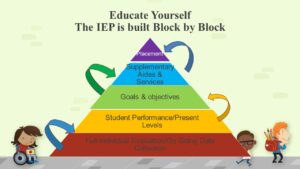In order to access the general education curriculum in the least restrictive environment (LRE), children with disabilities may require supplementary aids and services. IDEA defines supplementary aids and services as those “aids, services, and other supports that are provided in regular education classes, other education-related settings, and in extracurricular and nonacademic settings, to enable the child with a disability to be educated with nondisabled children to the maximum extent appropriate” (34 CFR §300.42).
Supplementary aids and services encompass a broad range of student supports, which include (but are not limited to):
- Accommodations – changes to materials or procedures that enable students with disabilities to participate meaningfully in learning and assessments. Examples include shortened assignments, extended time given for completing assignments, or preferential seating. Accommodations DO NOT change what the student is expected to master.
- Modifications – changes in what the student is expected to learn that is different from his or her grade-level curriculum. Examples include reducing the expectations for an assignment or test or modifying the work to a prerequisite skill level compared to the curriculum (TEKS). Modifications DO change what the student is expected to master.
- Assistive technology – items, devices or products that are used to increase, maintain, or improve the functional capabilities of a child with a disability
- Adapted equipment – examples include a footstool for a student whose feet don’t comfortably reach the floor when sitting in a regular desk or wheelchair accessible playground equipment.
- Adapted materials – examples include large-print text books, writing tablets with raised lines, or soft pencil grips to help with manual dexterity.
- Communication aids – examples include sign language, interpreting services and assistive and augmentative communication devices.
- Resource support – one-on-one or small group work in subject areas where the student needs re-teaching, tutoring or slower-paced instruction.
- Paraprofessional support – sometimes called an “aide,” the paraprofessional provides instructional support under the direct supervision of a highly qualified teacher.
- Collaborative teaching – the special education teacher acts as a co-teacher in the general education classroom (direct instruction) or as a “consultant” to the general education teacher (indirect instruction). Note: When the IEP calls for coordination between regular and special education teachers, parents should be clear on how responsibilities will be divided: who will be responsible for instruction, who will be responsible for modifications, and who will assign grades.
- Staff development – this includes training and supports needed by the teacher in order to implement the student’s IEP.
- Peer tutoring or assistance – natural supports in the classroom. Some students learn best through peer modeling and interactions, and this practice often initiates friendships between students with and without disabilities.
What Parents Need to Know
Like all special education services, supplementary aids and services are based on the individual needs of the student, not what the parent may want for their child. Supplementary aids and services are provided at no cost to the parent.
Supplementary aids and services are provided in addition to “related services,” although there can be some overlap between the two. Related services focus on the therapeutic, corrective, and medical supports the student needs in order to benefit from special education, such as speech therapy or mobility services. Special transportation may also fall under related services. (See Related Services – Frequently Asked Questions.)
It is the role of the ARD Committee to explore, recommend and document the appropriate supplementary aids and services that will support the student in the least restrictive environment. The time to discuss supplementary aids and services should be indicated on the ARD agenda, following a review of evaluation data, Present Levels of Academic and Functional Performance (PLAAFP) and annual goals. Placement decisions should be made only after the ARD Committee reviews the supplementary aids and supports the child will need in order to function in the least restrictive environment.

Schools are required to implement the supplementary aids and services only as they are defined in the student’s IEP. Therefore, parents should ensure that the agreed upon supports and services are clearly documented in the IEP paperwork.
Remember that the law requires that supplementary aids and services be provided as necessary to allow students with disabilities to participate “in extracurricular and nonacademic settings” with their peers without disabilities. When discussing supplementary aids and services, make sure the ARD Committee has thought through the student’s entire school day and schedule, including playground activities, lunch, and extracurricular activities.
Resources
Inclusion in Texas Statewide Network:
- Accessibility & Specialization Tools
- Accommodation Companion Guidelines UDL Implementation Guideline
- Guidelines for Co-teaching
- Working with Paraprofessionals
Center for Parent Information and Resources
Legal Framework for the Child Centered Special Education Process – Supplementary Aids and Services, Special Education, Related Services
Region 10 Dyslexia Accommodations
National Center on Accessible Educational Materials (AEM)
National Center on Universal Design For Learning
Texas Education Agency
- Accommodation Resources
- Accessible Instructional Materials
- Resources for Teachers By Disability (Includes Instructional strategies and accommodations)
- Providing Counseling as a Related Service
- Remote Counseling and Student Support Services
- OT and PT Guidance
- Speech Language Therapy Guidance
Texas Project FIRST – Technology Resources
The Peal Center




